Occupational environment monitoring of a seafood processing factory
99,000 ₫
Note: The above price is calculated for one sample, and the price may fluctuate depending on the area of the environment to be monitored and market movements. For more accurate pricing support, please refer to the price list or contact our consulting staff directly.
Monitoring the environment of a seafood processing factory is a session of collecting, analyzing, and evaluating factors at the workplace that may harm workers health.
Table of Contents
Toggle1. Overview of Seafood Processing Factories
a. What is a Seafood Processing Factory?
A seafood processing factory is a facility that performs manufacturing and processing of products from seafood raw materials. These factories are usually built near seaports or areas with abundant seafood resources.
The main tasks of a seafood processing factory are receiving, processing, and manufacturing products from raw materials such as fish, shrimp, crab, clams, oysters, and other seafood.

b. Production Stages in Seafood Processing Factories
Production stages in seafood processing factories may include the following:
- Receiving and processing raw materials:
- Receiving seafood raw materials from suppliers, including fishing boats, fish stations, or other factories.
- Inspecting the quality of seafood raw materials, including checking freshness, quality, and food safety standards.
- Cleaning and processing raw materials, including scaling, deboning, gutting, and removing other unnecessary parts.
- Processing and preservation:
-
- Cutting, grinding, or processing raw materials into seafood products such as fish fillets, fresh shrimp, dried squid, or fish balls.
- Freezing: Using refrigeration systems to freeze seafood raw materials, preserving quality and freshness.
- Cooking or steaming: Processing seafood raw materials at high temperatures to ensure thorough cooking and food safety.
- Seasoning: Applying spices, salt, sugar, or other flavorings to enhance taste and flavor of seafood products.
- Quality inspection:
-
- Performing quality control during manufacturing, including checking shape, color, aroma, texture, chemical composition, and food safety standards.
- Ensuring that products meet quality, safety requirements, and comply with food industry regulations.
- Packing and transportation:
-
- Packing seafood products into suitable packaging, including cardboard boxes, vacuum bags, or protective packaging that meets storage and transport requirements.
- Labeling products with information about origin, ingredients, expiration date, and food safety regulations.

c. Machinery Used in Seafood Processing Factories
In seafood processing factories, various machines are used to perform manufacturing and processing stages. Common machinery includes:
- Scaling machines: Used to remove fish scales before further processing.
- Deboning machines: Used to remove bones from fish meat to ensure the final product is bone-free.
- Cutting and cleaning machines: Automatic cutters are used to cut seafood into small pieces or final products of desired size and shape. Cleaning machines remove unwanted parts such as skin, bones, or intestines.
- Freezing machines: Used for rapid cooling of seafood raw materials such as fish and shrimp to maintain freshness and quality.
- Steaming and cooking machines: Used to steam or cook seafood to ensure proper cooking and food safety.
- Seasoning machines: Used to add spices to seafood products, including salt, sugar, and other flavorings.
- Packing machines: Used to pack seafood products into suitable packaging, such as cardboard boxes, vacuum bags, or protective packaging.
- Quality inspection machines: Machines used to check product quality, including color, shape, size, chemical composition, and food safety standards.
These machines play an important role in seafood manufacturing and processing, increasing productivity, quality, and efficiency.

d. Occupational Diseases for Workers in Seafood Processing Factories
Workers in seafood processing factories may develop some occupational diseases related to their work environment. Common occupational diseases include:
- Allergies: Workers may develop allergies due to exposure to allergenic substances such as fish protein, seafood, or chemicals during processing.
- Dermatitis: Prolonged contact with seawater, cleaning agents, disinfectants, or other chemicals may cause skin inflammation, irritation, or eczema.
- Respiratory diseases: Vapors and dust from seafood processing can cause respiratory issues, such as bronchitis, asthma, or occupational lung diseases.
- Musculoskeletal and spinal disorders: Working in environments with heavy lifting or improper posture may lead to spinal, muscular injuries or degenerative conditions like spondylosis, joint degeneration, or bursitis.
- Hearing problems: Noise from some processing stages may damage hearing, causing hearing loss, tinnitus, or middle ear infections.
- Infectious diseases: Seafood processing may involve exposure to bacteria, viruses, or other pathogens, causing infectious diseases such as diarrhea, skin infections, or respiratory infections.

e. Products in Seafood Processing Factories
Seafood processing factories produce a wide variety of products from seafood raw materials. Common products include:
- Fresh fish: Packed and preserved to maintain freshness. Fresh fish may be sold directly to consumers or used in other food manufacturing.
- Frozen seafood: Fish, shrimp, squid, and other seafood frozen to extend shelf life. These products may be exported or used in food manufacturing industries.
- Salted fish: Fish preserved with salt for culinary purposes.
- Dried squid: Processed and dried squid used in various dishes and traditional recipes.
- Fish oil: Extracted from fish for use in food industries, fish oil production, or as ingredients for other products.
- Seafood seasoning products: Includes fish sauce, fish soy sauce, fish-based sauces, and other seasonings to enhance flavor in dishes.
These are examples of common products. Depending on the scale and processes of each factory, other products may also be produced.

2. Overview of Occupational Environment Monitoring Services
a. What is occupational environment monitoring in seafood processing factories?
Occupational environment monitoring (or workplace environmental measurement) in seafood processing factories involves collecting, evaluating, and analyzing measurements of workplace environmental factors to implement timely solutions, minimize environmental hazards to workers’ health, and prevent occupational diseases. Monitoring the occupational environment is mandatory for seafood processing factories.
Occupational environment monitoring plays a key role in protecting and enhancing workers’ health because the workforce is the main resource of a business and directly generates profit. Workers regularly exposed to hazardous factors exceeding permissible limits are at risk of health problems and occupational diseases.
REGISTER FOR OCCUPATIONAL ENVIRONMENT MONITORING SERVICE
b. An Toan Nam Viet’s Occupational Environment Monitoring Program
An Toan Nam Viet’s occupational environment monitoring program is developed by monitoring engineers in occupational safety and environmental protection. Aiming to ensure workers’ health and safety, the program uses modern measurement methods to monitor air quality, water, microclimate factors, physical factors, dust, and more in the workplace. This program is crucial for ensuring a safe work environment and protecting workers’ health.
Additionally, An Toan Nam Viet’s program contributes to research and development of new solutions to improve workplace environmental quality. With a dedicated and professional team, An Toan Nam Viet’s exclusive monitoring program is a breakthrough in occupational safety management and environmental protection in Vietnam.

c. Standardization in Workplace Measurement Procedures
Standardization in workplace measurement procedures at An Toan Nam Viet is very important for ensuring the accuracy of measurement results. To guarantee the reliability of collected data, the program applies recognized standards and procedures from the Ho Chi Minh City Department of Health. This ensures that the collected data can be reliably used for evaluating workplace environments and making decisions to improve working conditions and protect workers’ health.
These standardized procedures also ensure that measurements are conducted by highly qualified monitoring specialists with years of experience, enabling managers and experts to trust An Toan Nam Viet’s results and make accurate, valuable decisions in safeguarding workers’ health and the environment.
By applying standardized workplace measurement procedures, An Toan Nam Viet demonstrates its commitment to ensuring a safe working environment and protecting workers’ health, while contributing positively to the development and improvement of occupational safety and environmental management in Vietnam.
d. Reporting Results of Seafood Processing Factory Monitoring
Occupational environment monitoring results are prepared according to Form No. 04, Appendix III issued with Decree 44/2016/ND-CP and are prepared in 2 copies: one copy is sent to the workplace that contracted the monitoring service, and one copy is kept by the organization performing the monitoring.
The retention period for occupational environment monitoring results follows legal regulations, which require indefinite record storage.

e. Frequency of Occupational Environment Monitoring According to the Law
According to Clause 2, Article 18 of the Labor Safety and Hygiene Law 84/2015/QH13, employers must conduct occupational environment monitoring to evaluate harmful factors at least once a year.
f. Deadline for Submitting Occupational Environment Monitoring Reports According to the Law
The deadline for submission is before December 31 every year. Enterprises operating production facilities are required to submit occupational environment monitoring reports to the Department of Health at the locality where the main office is located and where workers are employed.
Whenever there are changes in technology, manufacturing processes, or when renovating or upgrading a facility that may introduce new harmful factors to workers’ health, enterprises must update occupational hygiene records regarding the harmful factors that require monitoring.
g. Penalties for Violations of Occupational Environment Monitoring by Employers
According to Article 27 of Decree No. 12/2022/ND-CP dated January 17, 2022, regulating administrative penalties in labor, social insurance, and Vietnamese workers working abroad under contracts:
- Clause 2: Fines of VND 2,000,000 – 5,000,000 for employers who fail to publicly disclose monitoring results to employees at the monitoring site and at places where hazardous factors are controlled immediately after obtaining the results of occupational environment monitoring and hazardous factor evaluation.
- Clause 3: Fines of VND 20,000,000 – 40,000,000 for employers who do not conduct occupational environment monitoring to control the impacts on workers’ health as required by law.
- Clause 4: Fines of VND 40,000,000 – 60,000,000 for employers who collude with monitoring organizations to commit fraud in occupational environment monitoring activities but not to the extent of criminal liability.
3. Harmful Environmental Factors for Workers in Seafood Processing Factories
Workers in seafood processing factories may be exposed to various harmful environmental factors. The main ones include:
- Toxic fumes: During seafood processing, toxic fumes may arise from chemicals such as ammonia, hydrogen sulfide, formaldehyde, and other compounds. These fumes can irritate the eyes, nose, throat, and lungs, causing breathing difficulties, respiratory infections, and affecting workers’ overall health.
- Dust and particles: Processing seafood can generate dust and particles from handling and processing raw materials. These may contain bacteria, viruses, chemical compounds, and allergens. Prolonged exposure can lead to pneumonia, rhinitis, bronchitis, and other respiratory issues.
- Noise: Activities in seafood processing factories, such as operating machinery, handling, and transporting products, can produce high noise levels. Prolonged exposure can damage hearing, cause stress, disrupt sleep, and affect workers’ general health.
- Temperature and humidity: Working conditions in seafood processing factories may involve high temperature and humidity due to processing and storage procedures. Inappropriate temperature and humidity can cause fatigue, discomfort, and affect workers’ health and performance.
- Chemicals: Seafood processing involves the use of preservatives, cleaning agents, and disinfectants for product preservation and handling.
REGISTER FOR OCCUPATIONAL ENVIRONMENT MONITORING SERVICE
4. Measures to Improve Working Conditions in Seafood Processing Factories
To improve the working environment in seafood processing factories and protect workers’ health, the following measures can be applied:
- Ventilation and fume extraction: Ensure effective ventilation systems and fume extraction devices to remove toxic fumes, dust, and particles from the processing environment. This helps reduce exposure to harmful substances and improves air quality in the factory.
- Use of personal protective equipment (PPE): Provide workers with complete PPE, including masks, goggles, gloves, protective clothing, and safety shoes, and ensure they use them correctly to protect against harmful environmental factors.
- Training and guidance: Train workers on occupational safety, safe working procedures, and proper use of PPE. This helps them understand environmental risks and know how to protect themselves.
- Machine inspection and maintenance: Conduct regular inspection and maintenance of machinery and equipment to ensure safe and efficient operation. This reduces the risk of accidents and maintains a clean and safe working environment.
- Waste management: Establish a waste management system to safely handle and dispose of processing waste, protecting the environment. Ensure compliance with regulations for disposing of hazardous and medical waste.
- Regular workplace monitoring: Conduct periodic checks to assess air quality, noise, temperature, and other environmental factors.
- Periodically conduct occupational environment monitoring in the factory, collect and analyze harmful factors affecting workers, then implement adjustments to reduce risks and prevent occupational diseases for them.
5. Benefits of Regular Monitoring in Seafood Processing Factories
An Toan Nam Viet provides businesses with great benefits when using occupational environment monitoring services in accordance with Decree 44/2016/ND-CP on managing and controlling harmful factors in the workplace affecting workers.
- Businesses can proactively control harmful factors in workshops or factories.
- Receive advice and recommendations on measures to reduce harmful factors and improve workplace environment quality.
- Indirectly protect human resources, a key factor in business development.
- Reduce the impact of occupational diseases on workers’ health, lowering future treatment costs.
- Improve workers’ health, leading to better product quality and consistent production output.
- Comply with labor safety regulations and avoid legal risks.
- Enhance reputation and professionalism, elevating the business’s brand.
Nam Viet’s occupational environment monitoring service is a solution to reduce occupational disease risks, contributing to a healthy and high-quality working environment.

6. National Occupational Environment Monitoring Center
Nam Viet Occupational Environment Monitoring Center is a professional unit specializing in supervising and measuring workplace environmental quality throughout all provinces in Vietnam. With an experienced team of monitoring specialists, the center uses modern measurement devices to ensure accuracy and reliability.
In addition to monitoring services, the center assists clients in planning, handling, and tracking workplace environmental issues. Following the motto “customer-centered,” the center prioritizes client satisfaction, meets all needs, and provides the best solutions for businesses.
REGISTER FOR OCCUPATIONAL ENVIRONMENT MONITORING SERVICE
With investments in technology, equipment, and workforce, Nam Viet’s monitoring center has become one of the most reputable units in occupational environment monitoring in Ho Chi Minh City with the following goals:
- We always value brand reputation and the quality of our services.
- We provide clients with the best and most suitable solutions possible.
- Alongside a team of experienced Masters and Engineers, we aim to protect the environment and benefit businesses.
- Working with Nam Viet Environmental Monitoring, companies receive professional service from experts and the best cost advantages.
The occupational environment monitoring process at Nam Viet includes the following basic steps:
- Before monitoring, all equipment is calibrated and compliant with legal regulations.
- Carry out the monitoring process fully and correctly as committed to the Department of Health.
- Accurately report monitoring results to employers.
- If results indicate unsafe conditions, Nam Viet provides corrective solutions, and the facility implements the following:
- Implement measures to improve working conditions, minimizing harmful factors and preventing occupational diseases.
- Organize health checkups to detect occupational and work-related diseases early for employees in unsafe positions.
- Provide material support to employees according to labor law regulations.

7. Pricing for Occupational Environment Monitoring
To help businesses carry out occupational environment monitoring professionally and effectively, Nam Viet provides clients with a detailed and reasonable price list for monitoring services.
- The price list provides detailed information about the costs of monitoring services, including transportation, measurement, analysis, and reporting. Clients can trust the accuracy and reliability of the reports.
- We always offer competitive and reasonable prices and are ready to answer all inquiries quickly and professionally.
- With Nam Viet’s price list, clients can easily select service packages that suit their needs. We commit to delivering maximum satisfaction with professional service quality.
1 review for Occupational environment monitoring of a seafood processing factory
No comments yet


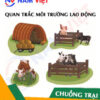
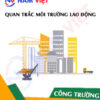


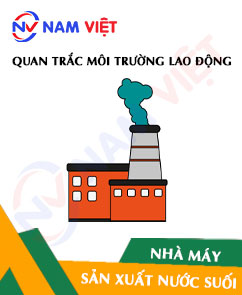
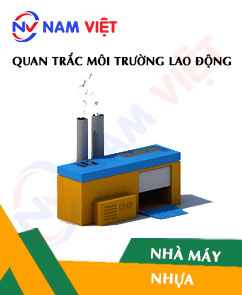



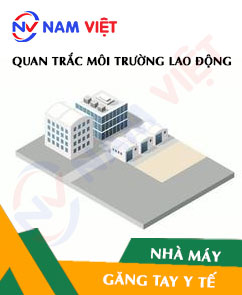
maituyet.cuong12
Good labor environment monitoring service!